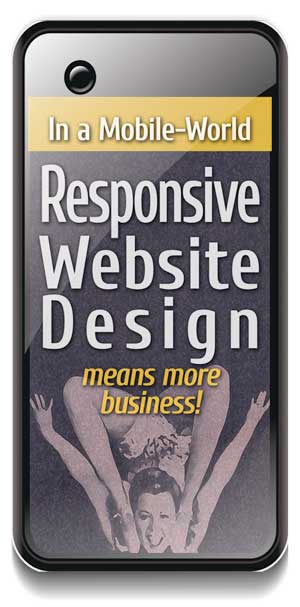Responsive Web Design Simply Explained
Responsive web design is the hottest and most ubiquitous Internet trend going into 2013 and will be for years to come. But why? And just what does it mean to have a “responsive” or “fluid” website?
A Responsive Website Design means more business
Let’s begin by answering with some questions. Did you know that desktop search declined for the first time in the history of the Internet in September of 2012? Did you know that Facebook disclosed in its IPO Prospectus that 90 percent of its 900+ million users access their site via mobile device? Did you know that Twitter handles a whopping 1.6 billion search queries every day, has a 70 percent retention rate and of its 500+ million registered users, 55 percent access the social network via mobile? What these impressive figures mean is that people are increasingly accessing the Internet through their mobile devices. And while this doesn’t necessarily make desktop computers obsolete, it does mean your site, in order to stay in-line with technology, should be completely viewable and fully functional on a mobile scale.
Why Mobile-First
Mobile or adaptive design is fast becoming a must-have element for any website. By the end of 2012, Apple alone sold 85 million iPhones and 34 million iPads, according to the Washington Times–and those numbers don’t include Sony, Samsung, HTC, Windows, Motorola and other manufactures’ mobile devices.
Several other popular news media companies, including TIME and USA Today, are also taking advantage of [responsive design], which helps to neatly distribute content across a wide variety of devices, from desktop computer to smartphone and everything in between. It’s not just news outlets that have taken a responsive approach. In the ever-popular WordPress market, nearly all newly released themes come fully mobile-optimized, bearing the mark “responsive” on their download pages. —Mashable
So, any sites which do not have a liquid feature to make them accessible through mobile platforms are missing-out on millions of consumers being able to view their site alternatively to desktops. And that means web properties which do have progressive enhancement are going to be preferred by a majority of consumers. It’s also important to note that responsive website design not only makes a site accessible via smartphones and tablets, but makes them convenient for people to use at any time they wish. That translates into more pageviews, longer time on site and increased conversion rates.
httpv://www.youtube.com/watch?v=jI5wlKD4lO8
Implementing Responsive Web Design
Understanding the way people view a website and how they interact with it is key to implementing responsive design. For instance, if a site is an ecommerce store, then product browsing, a shopping cart and checkout are necessary for functional responsive cyber properties. If a website is selling a service, then it should accommodate visitors who want to book an appointment, schedule a service, or purchase a service on-demand. Other considerations about a mobile site is how it will interact with third-party platforms, such as social networks. Features are just as important. Every mobile site should have certain elements in order to be of the greatest use:
- Consistent branding. Your mobile site and desktop site should have the same look and feel for a sense of continuity.
- Calls to Action. Just like your desktop site, your mobile property should have conspicuous calls to action. Features like “Click to Call” are among the most important.
- Optimized images and code. Visitors will quickly bounce off a mobile site which doesn’t quickly load. Rather than wait, people will just click away and go elsewhere.
- Large buttons and easy navigation. A good responsive site takes into account the limitations of mobile devices. So, it should have big buttons and intuitive navigation.
- Link to your full site and conspicuous contact information. Mobile visitors may want to bookmark your full site and view it later on a desktop or email the URL to a friend–give them that opportunity. And because they’re already using their mobile device, be sure to have your phone number, address and email handy.
If you need a responsive design incorporated into your website, then contact us for a free consultation. We can make your site viewable and functional for any mobile device.

